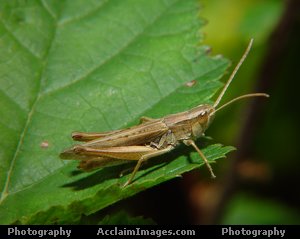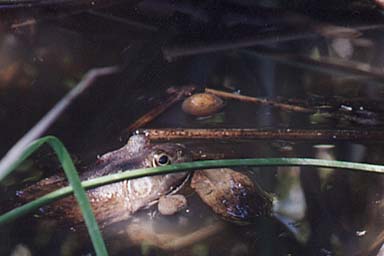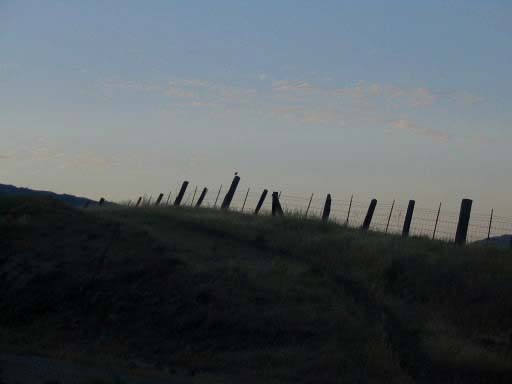Dusk brings on an increase in activity in the Canyon. As the sun begins to set, you will first hear a few crickets. Then, if you are near a spring or a water reservoir, you will definitely hear a bullfrog or two. In about ten minutes, there will hear the music of many frogs and crickets. There are countless creatures that live in Poly Canyon, and here are a few that we had the pleasure of seeing, even if for only a moment.
Rabbits:
2.JPG) Rabbits and hares have large front teeth, short tails, and large hind legs and feet adapted for running or jumping. In most, the length of the ears is considerably greater than the width. Although usage varies, the term rabbit generally refers to small, running animals, with relatively short ears and legs, which give birth to blind, naked young. A hare is a larger, hopping form, with longer ears and legs, whose young are born furred and open-eyed. Rabbits are chiefly nocturnal, although they are sometimes seen in the daytime. They have acute senses of smell and hearing. They feed on a wide variety of vegetation and are responsible in many areas for the stunted nature of the ground cover. When feeding on green herbage, rabbits, like hares, excrete soft pellets which they re ingest; the waste products of the re digested food are excreted as dry pellets. Wild rabbits are frequently infected with tularemia , which is dangerous to humans. (Directly quoted from referenced site)
Rabbits and hares have large front teeth, short tails, and large hind legs and feet adapted for running or jumping. In most, the length of the ears is considerably greater than the width. Although usage varies, the term rabbit generally refers to small, running animals, with relatively short ears and legs, which give birth to blind, naked young. A hare is a larger, hopping form, with longer ears and legs, whose young are born furred and open-eyed. Rabbits are chiefly nocturnal, although they are sometimes seen in the daytime. They have acute senses of smell and hearing. They feed on a wide variety of vegetation and are responsible in many areas for the stunted nature of the ground cover. When feeding on green herbage, rabbits, like hares, excrete soft pellets which they re ingest; the waste products of the re digested food are excreted as dry pellets. Wild rabbits are frequently infected with tularemia , which is dangerous to humans. (Directly quoted from referenced site)
Diurnal Birds:
Blackbird:
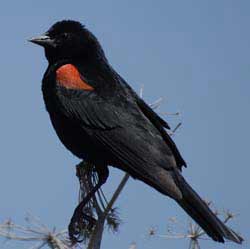 Birdsongs increase as well and the blackbird's song is more frequently heard at dusk. By the time it is dark, there is an entire symphony. Click here to hear the frogs recorded by the Indonesian Reservoir, home also of the red-winged blackbird. The above photo is of the red-winged blackbird, which can be found throughout Poly Land. Click on the bird picture and you can listen to Sarah McLachlan sing "Blackbird" while you view this site.
Birdsongs increase as well and the blackbird's song is more frequently heard at dusk. By the time it is dark, there is an entire symphony. Click here to hear the frogs recorded by the Indonesian Reservoir, home also of the red-winged blackbird. The above photo is of the red-winged blackbird, which can be found throughout Poly Land. Click on the bird picture and you can listen to Sarah McLachlan sing "Blackbird" while you view this site.
California Quail:
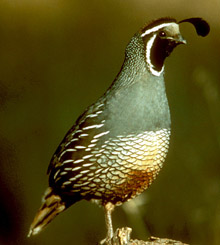 California Quail are most commonly found in the west coast regions of the United States, but can also be found in Northern Nevada, New Mexico, Hawaii and Utah. California Quail prefer living in open woodlands, bushy foothills, valleys with streams, live-oak canyons and suburban towns. They can be identified by their prominent teardrop-shaped plume or a double plume on the forehead. On our first night-hike we encountered a large bushy area in a little depression between two mountains. There was a strange noise coming from the bushes and we were determined to find out what it was. We all took up posts around the wooded area hoping to see something fly out at us. We then tossed little pieces of bark into the bramble to try and flush whatever it was out. It didn't work. By tossing the bark in different areas of the brush, we determined that there was definitely more than one creature, but the noises varied. There was a flapping noise that made us think that it could be a bird - or perhaps a bat. There was also a shuffling noise like footsteps. Then, there was a clicking noise. They seemed to be spread about five to ten feet apart. The next day we explained what we heard to Dr. Marx and he informed us that the clicking was a tell tale call of the California Quail. Later, on our bird hike, we learned that quail roost at night in a circle, tails out. The shuffling was probably due to the fact they would rather walk than fly, which is why the tossing bark wasn't an incentive enough for them to fly away. The quail stands a good chance of staying protected from predators (the ones we encountered were in brush filled with with poison oak).
California Quail are most commonly found in the west coast regions of the United States, but can also be found in Northern Nevada, New Mexico, Hawaii and Utah. California Quail prefer living in open woodlands, bushy foothills, valleys with streams, live-oak canyons and suburban towns. They can be identified by their prominent teardrop-shaped plume or a double plume on the forehead. On our first night-hike we encountered a large bushy area in a little depression between two mountains. There was a strange noise coming from the bushes and we were determined to find out what it was. We all took up posts around the wooded area hoping to see something fly out at us. We then tossed little pieces of bark into the bramble to try and flush whatever it was out. It didn't work. By tossing the bark in different areas of the brush, we determined that there was definitely more than one creature, but the noises varied. There was a flapping noise that made us think that it could be a bird - or perhaps a bat. There was also a shuffling noise like footsteps. Then, there was a clicking noise. They seemed to be spread about five to ten feet apart. The next day we explained what we heard to Dr. Marx and he informed us that the clicking was a tell tale call of the California Quail. Later, on our bird hike, we learned that quail roost at night in a circle, tails out. The shuffling was probably due to the fact they would rather walk than fly, which is why the tossing bark wasn't an incentive enough for them to fly away. The quail stands a good chance of staying protected from predators (the ones we encountered were in brush filled with with poison oak).
Western Meadowlark:
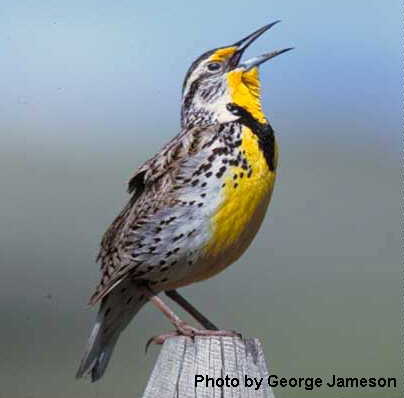 The Western Meadowlark is about eight and a half inches long with a sharp, pointy bill and rusty yellow under parts. It has a black V on it's chest and brown stripes on its head. Its flanks are white with back streaks and its upper parts are brown with black streaks. It has a brown tail and its outer tail feathers are white.
The Western Meadowlark is about eight and a half inches long with a sharp, pointy bill and rusty yellow under parts. It has a black V on it's chest and brown stripes on its head. Its flanks are white with back streaks and its upper parts are brown with black streaks. It has a brown tail and its outer tail feathers are white.
These birds prefer grasslands and they build their cup-like nests low to the ground. They eat insects and seeds.
Text References
http://www.encyclopedia.com/html/r1/rabbit.asp
http://www.mbr-pwrc.usgs.gov/id/framlst/i5011id.html
http://animaldiversity.ummz.umich.edu/site/accounts/information/Callipepla_californica.html
Assorted Sounds:
Picture References
Red Winged Blackbird
California Quail
Western Meadowlark
Including photography by Bryan Nay
Audio References
I am Sam. V2 Records Inc., Blackbird originally performed by the Beetles, performed here by Sarah Mclachlan
Above - original audio recorded by Mollie Small and Bryan Nay while on Cal Poly land
Home • Wildlife
• Domesticated
Animals • Plants
• Poetry and
Stories • About
Us • Site Map

2.JPG) Rabbits and hares have large front teeth, short tails, and large hind legs and feet adapted for running or jumping. In most, the length of the ears is considerably greater than the width. Although usage varies, the term rabbit generally refers to small, running animals, with relatively short ears and legs, which give birth to blind, naked young. A hare is a larger, hopping form, with longer ears and legs, whose young are born furred and open-eyed. Rabbits are chiefly nocturnal, although they are sometimes seen in the daytime. They have acute senses of smell and hearing. They feed on a wide variety of vegetation and are responsible in many areas for the stunted nature of the ground cover. When feeding on green herbage, rabbits, like hares, excrete soft pellets which they re ingest; the waste products of the re digested food are excreted as dry pellets. Wild rabbits are frequently infected with
Rabbits and hares have large front teeth, short tails, and large hind legs and feet adapted for running or jumping. In most, the length of the ears is considerably greater than the width. Although usage varies, the term rabbit generally refers to small, running animals, with relatively short ears and legs, which give birth to blind, naked young. A hare is a larger, hopping form, with longer ears and legs, whose young are born furred and open-eyed. Rabbits are chiefly nocturnal, although they are sometimes seen in the daytime. They have acute senses of smell and hearing. They feed on a wide variety of vegetation and are responsible in many areas for the stunted nature of the ground cover. When feeding on green herbage, rabbits, like hares, excrete soft pellets which they re ingest; the waste products of the re digested food are excreted as dry pellets. Wild rabbits are frequently infected with 
 California Quail are most commonly found in the west coast regions of the United States, but can also be found in Northern Nevada, New Mexico, Hawaii and Utah. California Quail prefer living in open woodlands, bushy foothills, valleys with streams, live-oak canyons and suburban towns. They can be identified by their prominent teardrop-shaped plume or a double plume on the forehead. On our first night-hike we encountered a large bushy area in a little depression between two mountains. There was a strange noise coming from the bushes and we were determined to find out what it was. We all took up posts around the wooded area hoping to see something fly out at us. We then tossed little pieces of bark into the bramble to try and flush whatever it was out. It didn't work. By tossing the bark in different areas of the brush, we determined that there was definitely more than one creature, but the noises varied. There was a flapping noise that made us think that it could be a bird - or perhaps a bat. There was also a shuffling noise like footsteps. Then, there was a clicking noise. They seemed to be spread about five to ten feet apart. The next day we explained what we heard to Dr. Marx and he informed us that the clicking was a tell tale call of the California Quail. Later, on our bird hike, we learned that quail roost at night in a circle, tails out. The shuffling was probably due to the fact they would rather walk than fly, which is why the tossing bark wasn't an incentive enough for them to fly away. The quail stands a good chance of staying protected from predators (the ones we encountered were in brush filled with with poison oak).
California Quail are most commonly found in the west coast regions of the United States, but can also be found in Northern Nevada, New Mexico, Hawaii and Utah. California Quail prefer living in open woodlands, bushy foothills, valleys with streams, live-oak canyons and suburban towns. They can be identified by their prominent teardrop-shaped plume or a double plume on the forehead. On our first night-hike we encountered a large bushy area in a little depression between two mountains. There was a strange noise coming from the bushes and we were determined to find out what it was. We all took up posts around the wooded area hoping to see something fly out at us. We then tossed little pieces of bark into the bramble to try and flush whatever it was out. It didn't work. By tossing the bark in different areas of the brush, we determined that there was definitely more than one creature, but the noises varied. There was a flapping noise that made us think that it could be a bird - or perhaps a bat. There was also a shuffling noise like footsteps. Then, there was a clicking noise. They seemed to be spread about five to ten feet apart. The next day we explained what we heard to Dr. Marx and he informed us that the clicking was a tell tale call of the California Quail. Later, on our bird hike, we learned that quail roost at night in a circle, tails out. The shuffling was probably due to the fact they would rather walk than fly, which is why the tossing bark wasn't an incentive enough for them to fly away. The quail stands a good chance of staying protected from predators (the ones we encountered were in brush filled with with poison oak). The Western Meadowlark is about eight and a half inches long with a sharp, pointy bill and rusty yellow under parts. It has a black V on it's chest and brown stripes on its head. Its flanks are white with back streaks and its upper parts are brown with black streaks. It has a brown tail and its outer tail feathers are white.
The Western Meadowlark is about eight and a half inches long with a sharp, pointy bill and rusty yellow under parts. It has a black V on it's chest and brown stripes on its head. Its flanks are white with back streaks and its upper parts are brown with black streaks. It has a brown tail and its outer tail feathers are white. 